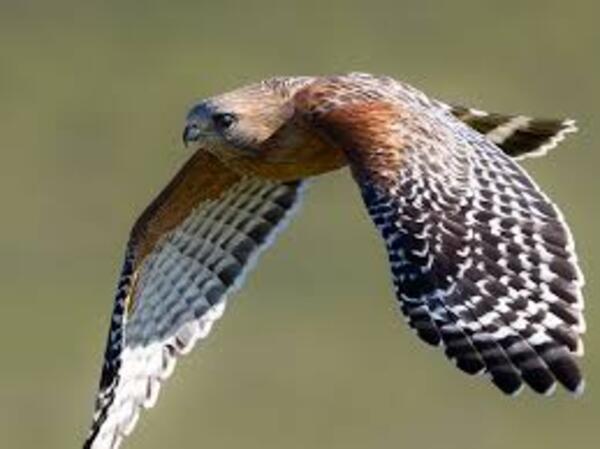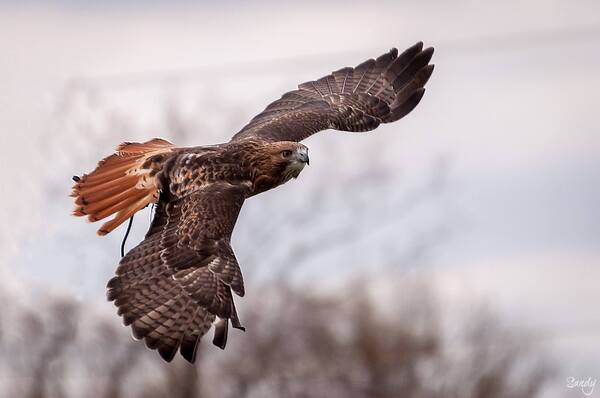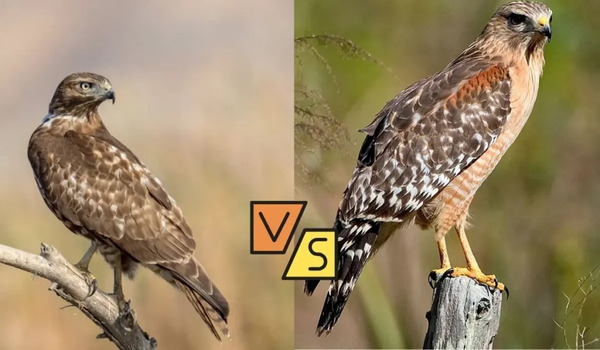Red-shouldered hawks and red-tailed hawks are both powerful and majestic birds of prey in North America. Though similar in some respects, they have unique characteristics that set them apart. This guide will explore their physical features, habitats, diets, behaviors, and key differences, helping bird enthusiasts and wildlife watchers easily tell them apart.
The red-shouldered hawk (Buteo lineatus) is a striking medium-sized bird of prey, known for its reddish-brown shoulders and characteristic checkered wings. Found primarily in North America, this hawk inhabits woodlands and prefers areas near water sources, such as rivers and marshes. With its unique vocalization, agile flight, and distinct coloration, the red-shouldered hawk is both captivating to observe and critical to its ecosystem.

Red-shouldered hawks are medium in size, with adults measuring about 17–24 inches in length and boasting a wingspan of 37–43 inches. Their weight ranges from 1 to 1.9 pounds, with females generally larger than males.
Coloration: The adult red-shouldered hawk has distinct reddish-brown plumage on its shoulders and chest, with a checkered pattern of dark brown and white on the wings. The breast has a striking orange-rust color, with barring across the belly. The tail is banded in black and white, adding to the bird’s distinctive look.
Juveniles: Young red-shouldered hawks look quite different from adults. Their plumage tends to be paler, with streaky brown and white coloring on the chest and wings. Juveniles also lack the prominent red shoulder markings until they mature.
Red-shouldered hawks are primarily found in the eastern United States and along the Pacific coast, extending into parts of Mexico and Central America. They prefer:
Wooded Habitats: These hawks thrive in forested areas, particularly in deciduous and mixed woodlands.
Near Water Sources: Their preferred habitats are often close to rivers, streams, swamps, and marshes, where they can easily find prey.
The eastern red-shouldered hawk is commonly seen in the southeastern United States, especially in states like Florida and Georgia. Western red-shouldered hawks inhabit areas along the Pacific coast, ranging from California to Oregon.
The red-shouldered hawk’s diet is diverse, allowing it to adapt to various forest environments. They primarily feed on small mammals, reptiles, amphibians, and occasionally insects. Here’s a breakdown of their diet:
Mammals: Small mammals, including mice, voles, and rabbits, are a staple in their diet.
Reptiles and Amphibians: Red-shouldered hawks are adept at catching frogs, snakes, and even small turtles. Their proximity to water sources allows them to target these species.
Insects: Insects such as grasshoppers and crickets make up a portion of their diet, especially in warmer months.
They hunt mainly from perches, using their sharp eyesight to scan for prey before swooping down with precision. In densely wooded areas, they often use a “perch and pounce” technique, waiting for the right moment to attack from a branch.
One of the most distinguishing traits of the red-shouldered hawk is its vocalization. Their call is loud and piercing, often described as a repetitive, high-pitched “kee-yee, kee-yee.” They are among the noisiest hawks, especially during the breeding season when both males and females call frequently to establish territory.
Red-shouldered hawks are also social raptors and may exhibit cooperative behavior. For instance, in certain habitats, they tolerate nesting near other hawks, sometimes even cooperating with other red-shouldered hawks to protect their territories.
Red-shouldered hawks form long-term monogamous pairs, often returning to the same nesting territory year after year. They prefer high nesting sites in tall trees, usually 20 to 60 feet off the ground. Both parents participate in building the nest, which is typically constructed from sticks and lined with leaves or bark.
Eggs: The female lays 2–5 eggs per breeding season, with incubation lasting about 33 days. Both parents take turns incubating, although the female handles the bulk of this responsibility.
Chicks: Once hatched, the chicks remain in the nest for around six weeks before fledging. During this period, the male provides food while the female protects and broods the young.
The red-shouldered hawk is currently listed as a species of “Least Concern” by the International Union for Conservation of Nature (IUCN). However, they face threats, primarily from habitat destruction, especially the clearing of forests and draining of wetlands. Because they rely on forested habitats near water sources, urban development poses a risk to their nesting and hunting grounds.
Red-shouldered hawks play a crucial role in controlling populations of small mammals and other prey species, helping to balance ecosystems. By preying on rodents, they indirectly benefit human agriculture by controlling pests that could harm crops.
Size: 17–24 inches, wingspan 37–43 inches.
Coloration: Red-brown shoulders, checkered wings, reddish barring on chest.
Habitat: Wooded areas near water, primarily in the eastern U.S. and Pacific coast.
Diet: Small mammals, amphibians, reptiles, and insects.
Call: Repetitive “kee-yee” sound, especially common during breeding season.
Conservation: Least Concern, though urban development impacts habitats.
The red-shouldered hawk is an extraordinary raptor, admired for its beauty and significant role in forest ecosystems. With its keen eyesight, distinctive vocalization, and diverse diet, it’s a remarkable sight in North America’s forests and wetlands.
The red-tailed hawk (Buteo jamaicensis) is one of the most widespread and recognizable raptors in North America. Known for its characteristic red tail and keen eyesight, this large, powerful bird of prey has adapted to diverse environments across the continent. Its versatile diet and soaring flight make it both a skilled hunter and an impressive sight in the wild.

Red-tailed hawks are large, robust raptors with a body length of approximately 18–26 inches and a wingspan of 43–57 inches. They can weigh between 1.5 to 3.5 pounds, with females typically larger than males.
Coloration: Adult red-tailed hawks are characterized by their rust-colored tail feathers, which give the species its name. Their back and wings are typically brown, while their undersides are lighter, often with a distinct band across the belly. There are regional color variations, with some birds appearing darker or lighter depending on their habitat.
Juveniles: Young red-tailed hawks do not have the iconic red tail. Instead, their tail feathers are brown with dark banding. They attain the red coloration in their tail after their first molt, usually around their second year.
Red-tailed hawks are highly adaptable and inhabit a wide range of environments throughout North America. They are found in grasslands, deserts, woodlands, mountainous regions, and even urban areas. Red-tailed hawks are also common in Central America and the Caribbean.
Open Landscapes: These hawks favor open areas, such as fields, plains, and deserts, where they can spot prey from a distance.
Urban Adaptation: In urban areas, red-tailed hawks have adapted to nesting on tall buildings and hunting small mammals in parks, making them one of the few large raptors to thrive in city environments.
Red-tailed hawks have a varied diet, allowing them to adapt to numerous habitats and food sources. Their primary prey consists of small to medium-sized mammals, though they also consume birds and reptiles when available.
Mammals: Small rodents, such as mice, voles, and squirrels, are staples in their diet, as well as rabbits.
Birds: Red-tailed hawks are capable of catching birds, including pheasants, pigeons, and other medium-sized birds.
Reptiles: In warmer regions, they hunt reptiles, such as snakes and lizards.
Red-tailed hawks are “sit-and-wait” hunters, perching on elevated vantage points like telephone poles or trees. They use their sharp eyesight to spot prey from great distances and then swoop down in a controlled dive to capture it. They are also known to soar in circles, utilizing thermal currents to conserve energy as they search for food.
The red-tailed hawk has a distinctive, raspy scream that is commonly used in movies to represent the sound of any eagle or hawk. This call, often transcribed as a high-pitched “kee-eeeee-arr,” is most frequently heard when defending territory or during courtship displays.
They are typically solitary but come together during breeding season and may be seen in pairs when hunting. Red-tailed hawks are also known to be aggressive defenders of their nests, especially when raising young.
Red-tailed hawks are monogamous, often forming lifelong pair bonds. Their nesting habits reflect their adaptability, as they may nest in trees, on cliff ledges, or on tall man-made structures in urban areas. Both males and females participate in building the nest, which can reach up to 3 feet in diameter.
Eggs: The female typically lays 1–3 eggs, which are incubated for about 28–35 days. Both parents share in the incubation, though the female does the majority of brooding.
Chicks: Once hatched, the young red-tailed hawks remain in the nest for 6–7 weeks, during which time they are fed by both parents. Fledging occurs after about 42–46 days, though they may stay close to the nest, continuing to rely on the parents for food.
The red-tailed hawk is classified as a species of “Least Concern” by the IUCN, owing to its large, stable population across North America. However, they still face risks from habitat destruction, illegal shooting, and collisions with vehicles and power lines. Despite these threats, their adaptability to various habitats, including urban areas, has allowed them to thrive.
Red-tailed hawks play a crucial role in controlling populations of small mammals, helping maintain ecological balance. By preying on rodents and other small animals, they indirectly benefit agricultural areas by reducing pest populations. They also serve as bioindicators, reflecting the health of their environments.
Size: Length 18–26 inches, wingspan 43–57 inches.
Coloration: Rust-colored tail (in adults), brown back, light undersides with a belly band.
Habitat: Versatile; found in grasslands, woodlands, deserts, mountains, and urban areas.
Diet: Small mammals, birds, reptiles.
Call: Iconic “kee-eeeee-arr” scream, often heard in media.
Conservation: Least Concern, adaptable to urbanization.
The red-tailed hawk is one of North America’s most adaptable and widespread raptors, a testament to its resilience and versatility. Its keen hunting skills, impressive flight, and unmistakable vocalizations make it a powerful presence across a diverse range of ecosystems.

While these hawks share the genus Buteo and exhibit some overlapping traits, their differences make them unique in appearance, behavior, and habitat preferences.
| Feature | Red-Shouldered Hawk | Red-Tailed Hawk |
|---|---|---|
| Size | 17–24 inches; wingspan 37–43 inches | 18–26 inches; wingspan 43–52 inches |
| Color | Reddish shoulders, checkered wings, and chest barring | Cinnamon-red tail, pale underparts, dark belly band |
| Tail | Narrow and banded with black and white | Broad and red, uniform cinnamon-brown |
| Habitat | Woodlands, forests near water | Wide range; open fields, forests, deserts |
| Diet | Small mammals, amphibians, reptiles, insects | Small to medium mammals, birds, reptiles |
| Call | Repetitive “kee-yee” | Hoarse “scream” or “kee-eeer” sound |
| Flight Style | Agile, often gliding between trees | Soaring with broad, sweeping wingbeats |
| Geographic Range | Eastern & Western U.S., parts of Mexico | Entire North America, including urban areas |
Physical Appearance: The red-shouldered hawk’s reddish-brown shoulders and checkered wings set it apart from the red-tailed hawk, which has a distinct red tail and a darker, banded belly.
Habitat Preference: Red-shouldered hawks prefer dense, forested areas with nearby water, while red-tailed hawks are highly adaptable, thriving in various habitats, including open fields and even cities.
Diet and Hunting: While both hawks hunt small mammals, the red-shouldered hawk’s diet includes more amphibians and insects due to its forested habitat, whereas the red-tailed hawk favors a more mammal-heavy diet.
Call and Behavior: The red-shouldered hawk’s call is repetitive and higher-pitched, while the red-tailed hawk has a raspy, prolonged “scream.” Red-tailed hawks are more likely to be seen soaring in open areas, while red-shouldered hawks prefer gliding between trees in forests.
Population and Conservation Status: The red-shouldered hawk (Buteo lineatus) is classified as Least Concern by the International Union for Conservation of Nature (IUCN), meaning it currently faces no significant threats to its population on a large scale. Its population in North America is estimated to be around 1.1 million individuals and appears stable. However, local populations may be impacted by habitat loss due to deforestation and urbanization, as red-shouldered hawks prefer forested areas near water sources.
Predators: Adult red-shouldered hawks have few natural predators due to their size and strength, but eggs and young birds are vulnerable to larger raptors like the great horned owl and eagles, as well as terrestrial predators like raccoons and snakes that may climb to access nests.
Population and Conservation Status: Like the red-shouldered hawk, the red-tailed hawk (Buteo jamaicensis) is listed as Least Concern by the IUCN, with a healthy and stable population estimated at approximately 2 million individuals in North America. Red-tailed hawks are highly adaptable and have even thrived in urban and suburban areas, which has contributed to their population resilience. However, they face threats such as vehicle collisions, power line electrocution, and occasional illegal shooting.
Predators: Adult red-tailed hawks face few natural predators but, like red-shouldered hawks, are vulnerable to larger birds of prey, especially when young. Great horned owls are known to occasionally kill red-tailed hawks, and terrestrial animals like coyotes and raccoons pose a threat to nests.
| Feature | Red-Shouldered Hawk | Red-Tailed Hawk |
|---|---|---|
| Conservation Status | Least Concern | Least Concern |
| Population Estimate | ~1.1 million individuals | ~2 million individuals |
| Primary Predators | Great horned owls, raccoons, snakes | Great horned owls, raccoons, coyotes |
| Population Threats | Habitat loss, urbanization | Vehicle collisions, power lines, shooting |
Both species are currently thriving, benefiting from their adaptability and conservation protections, though they face different regional pressures and threats.
Red-tailed hawks are the more commonly sighted species across North America due to their wide habitat tolerance. Red-shouldered hawks, while still widespread, are often harder to spot as they are more selective in their choice of forested habitats.
Both the red-shouldered hawk and red-tailed hawk are remarkable raptors with unique characteristics. Red-shouldered hawks are forest dwellers with a preference for water-rich areas, while red-tailed hawks are open-country hunters with a distinctive reddish tail. Each plays a vital role in its ecosystem, helping control populations of small animals and maintaining biodiversity. Whether you're watching the skies above woodlands or open fields, knowing these differences will help you confidently identify which hawk you’re observing.
animal tags: Red-Shouldered-Hawk Red-Tailed-Hawk
We created this article in conjunction with AI technology, then made sure it was fact-checked and edited by a Animals Top editor.